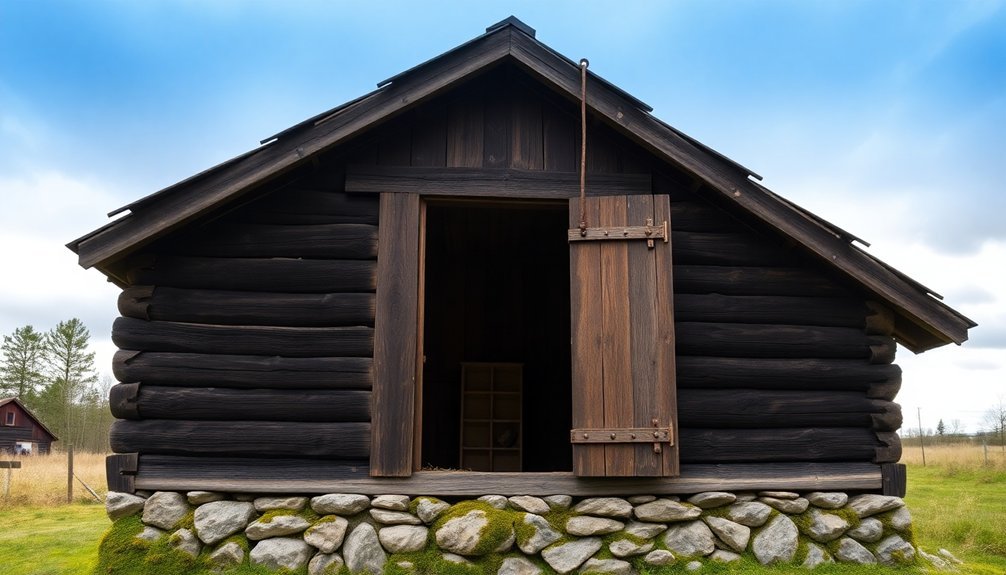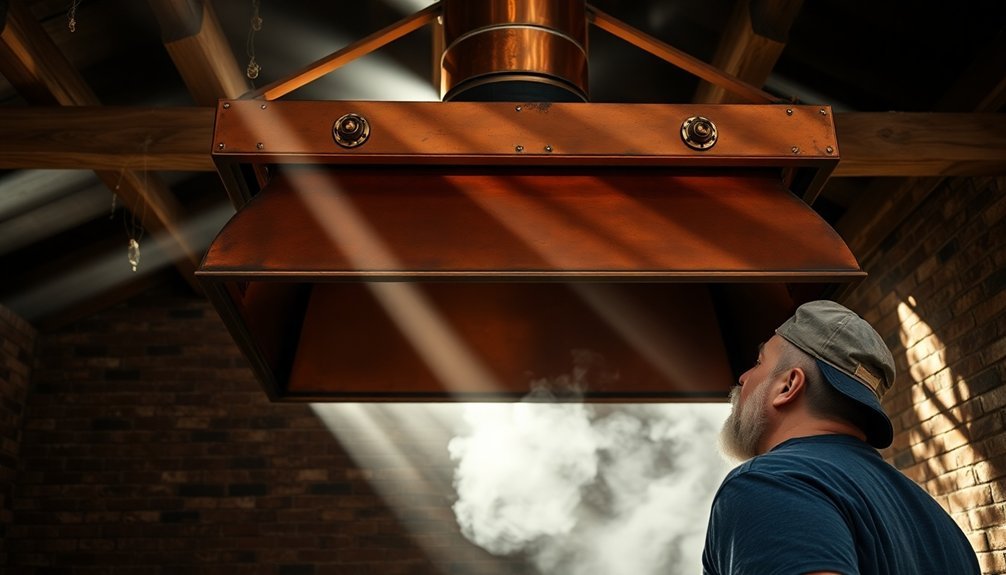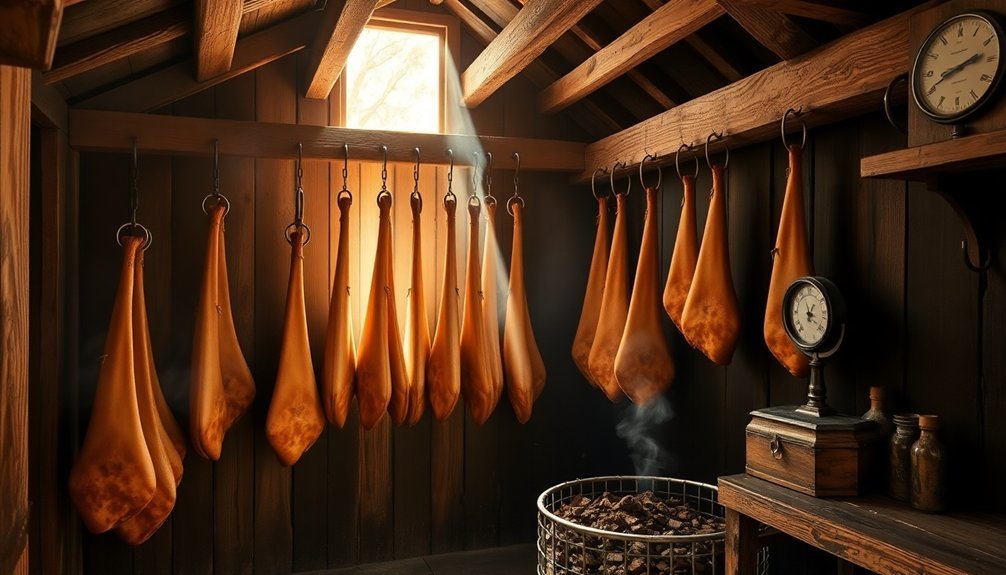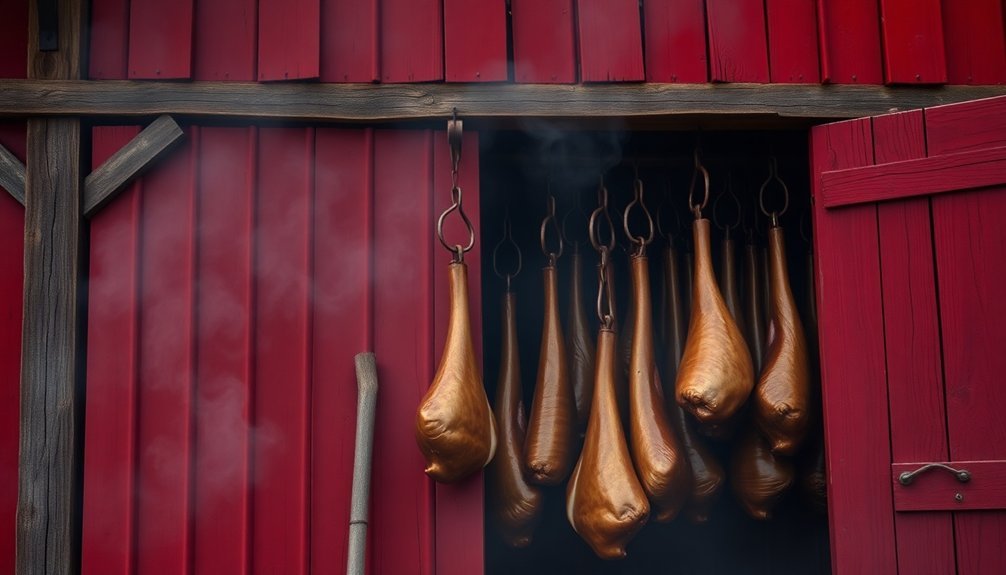Start your heritage smokehouse revival by inspecting the structure's foundation, walls, and chimney system for any compromised areas. You'll want to choose traditional hardwoods like hickory, oak, or maple while avoiding softwoods that can taint your meat's flavor. Maintain proper ventilation through quarterly checks of your system and regular cleaning of components. Master temperature control using manual vent adjustments or modern controllers, and don't forget to install a water pan for ideal heat retention. Embrace historic smoking techniques by keeping your fire chamber separate from your cooking chamber. These fundamental steps will set you up for authentic, time-honored smoking success.
Assessing Your Smokehouse Structure

Before diving into smokehouse restoration, a thorough assessment of your structure's condition will determine the scope of work needed. Start by examining major structural modifications that could have compromised the building's integrity.
Pay close attention to changes in orientation, removed features, or altered entrances that may affect its historical value. The ideal setup requires a proper intake screen system to prevent dangerous anaerobic conditions during smoking.
Check if previous owners have replaced original materials with non-authentic alternatives, such as modern siding or brick exteriors. You'll want to document these changes to plan your restoration strategy.
Don't forget to inspect any outbuildings connected to your smokehouse, as their condition can impact the overall restoration project.
Look for signs of structural weakness in the foundation, walls, and roof. If you find cinder blocks or concrete elements, verify they're still sound and serving their purpose.
Examine the chimney system carefully – it's essential for both safety and functionality. You'll need to guarantee all metal components, especially in the chimney, are food-safe and free from corrosion.
If you spot any recycled or found materials, evaluate their condition and determine if they need replacement or if they can be preserved as part of the structure's character.
Selecting Traditional Wood Types
With your smokehouse structure properly assessed, selecting the right wood becomes your next key focus. Traditional hardwoods remain the cornerstone of authentic smokehouse flavor, with each variety offering distinct characteristics for your meats.
You'll want to focus primarily on hardwoods like hickory, oak, and maple, steering clear of softwoods like pine and cedar that can taint your food with unwanted residues. Logs and chunks offer superior burn duration compared to smaller wood formats.
For your heritage smokehouse revival, consider these essential wood choices:
- Post-oak or live-oak for traditional brisket and beef cuts, delivering a bold, time-tested flavor profile
- Hickory for an authentic Southern BBQ experience, perfect for pork shoulders and chicken
- Maple when you're seeking subtle sweetness, especially for bacon and ham
- Fruit woods like apple or cherry for lighter meats and a delicate touch
- Pecan for achieving that coveted nutty undertone in your smoked meats
Choose wood splits or chunks over chips, as they'll provide longer-lasting smoke and better temperature control.
Your wood should be well-seasoned, never green or soaked, to guarantee clean smoke and consistent results.
Consider mixing woods like mesquite with milder varieties to create your signature flavor profile.
Ventilation System Maintenance

Maintaining your smokehouse's ventilation system requires three distinct maintenance schedules: quarterly, semi-annual, and annual inspections.
During quarterly checks, you'll need to inspect the system for corrosion and wear, clean the evaporator coils and blades, and verify that fans rotate smoothly without excessive noise. Following Heatcraft's maintenance guidelines will help ensure optimal performance.
Don't forget to check fan blade set screws and look for signs of stress or cracks.
Your semi-annual maintenance should include all quarterly tasks plus additional checks of compressor and heater contactors.
You'll want to verify the operation of timers, relays, and safety controls while guaranteeing the electrical cabinet remains clean and free from moisture, debris, and pests.
Annual maintenance focuses on detecting vibration issues in fan blades and panels.
You'll need to check for oil stains on headers and coils, clear debris from condensers, and guarantee fan motors are properly secured.
If your smokehouse includes smoke vents, follow NFPA 204 guidelines for annual inspections.
Replace fusible links older than five years, verify temperature settings work with your sprinkler system, and maintain detailed inspection records with appropriate tags and documentation.
Temperature Control Methods
Successful temperature control in your heritage smokehouse depends on mastering both traditional and modern methods.
You'll need to understand both manual vent adjustments and automated solutions to achieve consistent results. The key is maintaining proper airflow through your intake and exhaust vents while utilizing auxiliary methods for temperature stability.
For traditional control, make small, anticipatory adjustments to your vents before temperatures drift too far.
Keep your exhaust vent partially open to prevent smoke and gas buildup, and fine-tune the intake vent for primary temperature regulation.
Modern temperature controllers can simplify this process, offering precise, hands-off operation through automated fan systems.
Consider these essential temperature control elements for your smokehouse:
- Install a reliable water pan to act as a heat sink and moisture source
- Wrap bricks in foil to create additional heat retention surfaces
- Seal any unintended gaps to maintain consistent airflow patterns
- Position thermometer probes strategically for accurate monitoring
- Balance intake and exhaust vents to create ideal draft
Remember that your smokehouse operates like a large vehicle with a small engine – it takes time to reach temperature and requires patience to adjust.
Combine traditional methods with modern controllers for the best results.
Historic Smoking Techniques

While modern temperature control gives you precision, the time-tested methods of our ancestors offer valuable insights for your heritage smokehouse.
You'll find that traditional European designs separated the fire chamber from the cooking chamber, providing better control over both heat and smoke flow. This separation isn't just about safety – it's essential for achieving that perfect balance of temperature and smoke exposure.
To authentically recreate historic smoking techniques, you'll want to focus on two primary methods: cold smoking and hot smoking. Cold smoking requires exposing your salted meats to low temperatures for extended periods, while hot smoking actually cooks the meat as it smokes.
Choose your wood carefully – hardwoods like red Alder and broadleaf Maple will give you better results than softwoods, which contain too much pitch.
You can take inspiration from Central European design elements by incorporating proper chimney placement and ensuring smoke circulation throughout your smokehouse.
When building or renovating, stick to traditional materials like cinder block or concrete, but upgrade to stainless steel for your chimney to avoid toxic emissions.
Frequently Asked Questions
How Long Should I Let Smoked Meats Rest Before Serving?
You'll want to rest larger cuts like brisket for 1-4 hours and pork butt for at least 30 minutes up to 2 hours. Keep temps above 140°F for safety. Smaller cuts need just 15-30 minutes.
Can I Use My Heritage Smokehouse Year-Round in Different Weather Conditions?
You can use your heritage smokehouse year-round by adjusting for weather conditions. You'll need proper ventilation, insulation, and climate control measures. Just modify your cooking times and wood selection based on temperature and humidity.
What's the Ideal Internal Temperature for Different Types of Smoked Meats?
You'll want to hit 190-205°F for beef brisket, 145°F for pork loin, 170°F for whole chicken, and 135-140°F for lamb rack. Monitor temperatures closely with a meat probe for best results.
How Often Should I Clean and Sanitize My Smokehouse Equipment?
You'll need to clean your smoker daily by removing residue and washing racks. Do weekly vent checks, perform monthly deep cleans with degreaser, and schedule quarterly inspections of steam coils and gas systems.
Which Cuts of Meat Work Best for First-Time Smokehouse Operators?
Start with pork shoulder or chicken thighs – they're forgiving and flavorful. You'll find these cuts have enough fat to stay moist during smoking. Later, try beef plate ribs before tackling more challenging brisket.
In Summary
You'll find that restoring your heritage smokehouse connects you to time-honored traditions while creating incredible flavors. By focusing on structural integrity, choosing authentic woods, maintaining proper airflow, controlling temperatures precisely, and using historic smoking methods, you're not just preserving a building – you're keeping alive generations of smoking expertise. Start small, be patient, and let your restored smokehouse become part of your family's legacy.





Leave a Reply